Livestock is more important to the Mauritanian economy (13% of National Gross Domestic Product) compared with just 4% from crop production. It is surprising, therefore, that irrigation has so far contributed little to animal productivity given the limited carrying capacity and irregular inter-annual production of the extensive rangeland, and the need to import fodder concentrates to sustain livestock during the hot-dry season (April to June). Our hypothesis is that growing irrigated sorghum and cowpea planted late in the mild-dry season (December-January after rice harvest (November-December) would improve profitability and sustainability of irrigation schemes. The objective is to replace fodder concentrates, currently purchased abroad, by fodder grown in irrigation schemes. To test our hypothesis we performed an extensive survey of 12 villages located within a significant gradient of rainfall from West to South-East along the northern bank of the Senegal River and used a simulation model constructed to study interactions between traditional and irrigated grain and/or fodder crop. The results of this study reveal how the introduction of irrigated sorghum and cowpea sown late in the mild-dry season would, even at relatively moderate yields (2.8-4.1 and 1.4-2.1 t grain ha-1, for sorghum and cowpea, respectively), provide additional grain required by smallholder farmers and reduce costs of livestock production (30%). In addition, the introduction of these crops increases by 31 to 54% the household net agricultural production of households having only small ruminants and by 14 to 23% of households having both small ruminants and cattle. Extending the irrigated cropping season shares the depreciation costs over more crops and improves the sustainability of the irrigation schemes. The regions that would most benefit from these additional irrigated crops are Trarza and Gorgol where the demand and hence prices of sorghum and cowpea grain and fodder are higher than in the other regions.
In Mauritania, rangeland pasture production and cropping of high land (Dieri) and/or depressions (Bas–fonds) where local runoff accumulates provide the best opportunities for primary production during the wet season (July to September). In addition, during the mild-dry season (October to March, a dry period with relatively moderate temperatures), flood-recession agriculture is practiced along the bank of the Senegal River both on land close to the river that floods every year (Falo) and also in depressions within more extensive plain areas that flood variably from year to year (Walo). Pearl millet is the predominant crop in Dieri, sorghum in Bas-fonds and Walo and maize in the Falo. These cereals are usually grown associated with cowpea (Comas et al., 2012).
Once the wet season has finished, inland transhumant livestock gradually migrate south towards the river where they increasingly compete with sedentary livestock of the Senegal River villagers for fodder and watering until the following wet season. While sedentary herds can complement rangeland pasture with crop residues that become available in October (Dieri and Bas-Fonds), December (irrigated rice) and February (Walo and Falo) a significative feed deficit occurs during the hot-dry season (April-May to June-July) when farmers must buy fodder concentrates.
In response to the prolonged drought of 1968 to 1973, about 40,000 ha of Walo land were transformed in the 1980s into irrigated rice schemes protected from flooding by levee banks, although nowadays less than 50% of that area remains in production (Mateos et al., 2010). In general, farmers produce one rice crop per year leaving the land bare the remaining months despite continuing availability of water. Considering the importance of livestock in the Mauritanian economy (13% of National Gross Domestic Product compared to 4% from crop production), its profitability, and the limited carrying capacity and irregular inter-annual production of the rangeland together with the need to import fodder concentrates, it is surprising that irrigation contributes little to livestock production. At present, it is limited to direct grazing of paddy straw after harvest and more recently sale of paddy straw and bran to newly establish peri-urban dairy farming in the capital Nouakchott and the regional centers, Rosso and Boghé (Corniaux et al., 2001). To support the dairy development, importation of groundnut meal has increased markedly to average around 9,600 t annually during the 2000s (Direction Générale des Douane, 2012).
Our hypothesis is that growing irrigated sorghum and cowpea crops for animal fodder during the mild-dry season after rice harvest in November-December, would improve profitability and sustainability of irrigation schemes. For this, it must be demonstrated that the required investment is affordable, the production costs of grain and fodder are below market price and that there is no clash for labour with the traditional flood recession Walo crops that are planted from October onwards. Both sorghum and cowpeas are well known in the region and less demanding water than rice. To test our hypothesis we have used data from an extensive survey of 12 villages located within a significant gradient of rainfall from West to South-East along the northern bank of the Senegal River (Comas et al., 2012), and a simulation model (Connor et al., 2008) constructed to study interactions between traditional crops and rice in the region that included an optional second irrigated grain and/or fodder crop planted late during the mild-dry season. Proof of concept is an essential prelude to, and an encouragement for, validation by experimentation.
Surveyed villages
All households of 12 villages with small and medium-sized community-managed irrigation schemes (< 100 ha) spaced along the northern bank of the Senegal River were surveyed, ten in 2008 and two in 2009 (1,584 households in total). This area comprises, from West to South-East, the south-west of Trarza Region and southern parts of Brakna, Gorgol and Guidimaka (Figure 1). Survey information was recorded during personal interviews conducted by trained local technicians. Details of the survey were presented in Comas et al. (2012). In addition to information about farming systems and household characteristics, the following specific information on the management of livestock was collected; (1) numbers of cattle, donkeys, sheep and goats, (2) milk and meat production, (3) quantities and costs of inputs (wages of shepherds and costs of animal health products, and of fodder concentrates for the hot-dry season before the first rains) and (4) household consumption of milk and meat. In addition, a weekly survey of (5) retail prices of meat (beef, mutton and goat), milk (cow, sheep and goat), concentrated feed and fodder (sorghum stover, cowpea haulms and rice straw) was made from October 2008 to October 2009 in the riverside towns of Rosso, Boghé, and Kaédi to provide local data to supplement official statistics.
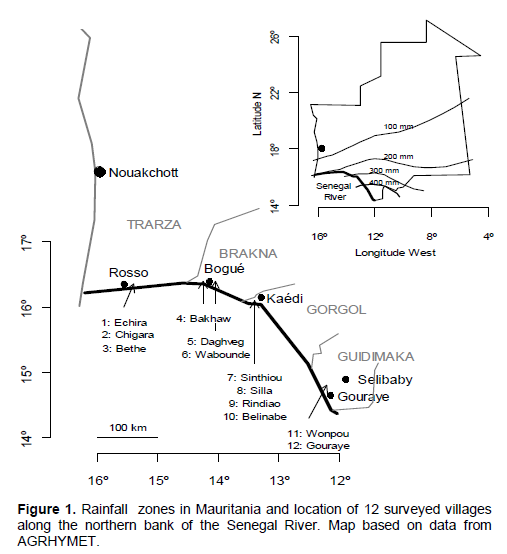
Stocking was expressed as tropical livestock units (TLU, live weight of 250 kg) using conversion ratios of 0.7, 0.5 and 0.1 to estimate TLU for cattle, donkeys and small ruminants, respectively. Daily dry matter intake needs of livestock were estimated at 2.75% of live weight, amounting annually to 2500 kg dry matter per TLU.
Simulation of irrigated sorghum and cowpea
Simulations of sorghum and cowpea crop development, growth and yield, and demand for irrigation water were developed from Connor et al. (2008). Variables used were daily rainfall, maximum and minimum temperatures, and sun hours. In addition, daily maximum and minimum relative humidity and wind speed were used to calculate reference crop evapotranspiration (ETo) using the Penman-Monteith equation. Meteorological data were available from three weather stations in Trarza (Rosso, 16.30º N, 15. 48º W), Gorgol (Kaedi, 16.09º N, 13. 30º E) and Guidimaka (Selibaby, 15.09º N, 12. 11º W) for the period 1961 to 2010.
These models integrate the effect of weather conditions, soil type, and management (crop, sowing time, yield and labor, costs of production and market prices) on the productivity of crops. Soils are defined according to rooting depth, water-holding capacity, drainage rate, and adequate fertility. Simulations of growth and yield were made through to maturity for crops sown from December (day 360) to early February (day 35). This option was chosen to avoid the subsequent hot-dry season of high water demand and uncertain crop productivity.
Current household net agricultural production
Current costs of production for traditional crops and irrigated rice were obtained from Comas et al. (2012). Livestock operating costs combine health products, shepherding, and supplementary fodder during the hot-dry season. The latter costed at market value. Distribution of production costs between milk and meat was made proportional to their mean market values. Household productivity of milk and meat was calculated from the number of cattle, sheep and goats per household, average yields of milk and meat, number of productive animals in the herd and average market price. This was done individually for the four regions in the survey using the following additional parameters: non-adult mortality rate (%), adult mortality rate (%), number of years required to reach reproductive maturity, reproduction rate (%), number of animals born at each birth, number of productive years of females. According to local experts (Kane, 1995) and Kane personal communication these parameters were set as follows: for cows, 15 and 10%, 4 years, 58%, 1 animal, and 11 years, respectively, and for small ruminants: 27.5 and 20%, 1 year, 90%, 1.2 animals and 8 years. Yield of carcass meat is taken as 52% of live weight according to the data in Mauritania. Current household net agricultural production was calculated as the sum of net production of traditional crops, rice and livestock.
Household net agricultural production in the new scenario
Household net agricultural production in the new scenario was calculated by adding to the net production of traditional crops, rice and livestock calculated previously the net production of crops produced after rice harvest and the related improvement to livestock production. Direct cost of production of irrigated late mild-season crops incurred includes labor, tractor for tilling the soil before planting, consumption of diesel fuel, fertilizer, seed, and pesticides, plus an interest charge of 15% p.a. for three months (sowing to harvest) according to yield obtained by simulation. Fodder production from crop residues was calculated as 2.5 times grain mass. Depreciation costs of construction of the irrigation perimeter and for purchase and maintenance of pumping equipment were established as in Comas et al. (2012) and distributed between rice and irrigated mild-season crops according to the consumption of diesel. Supplementary fodder during the hot-dry season was costed according to production while fodder concentrate, if needed, was costed at market price.
Simulation and statistical analysis software
Models for crop simulation analysis were constructed in Systems Thinking for Educational and Research (STELLA); details can be found in Connor et al. (2008). Computing and statistical analyses were made using statistical program of R Development Core Team. Since the distribution of most indices showed a positive skewed distribution, data were expressed in logarithmic form before statistical analysis. To test for differences between villages, analysis of variance and subsequent mean separation were performed using Least Significant Difference (LSD).
Climate in the study region and survey overview
Monthly average values of rainfall, ETo and temperature for Trarza, Gorgol and Guidimaka from 1961 to 2010 are presented in Figure 2. Rainfall is concentrated from June to October and shows a strong West to South-East increase (231-516 mm year-1). ETo follows the same seasonal trend at each site; rising to highest values in May and then decreasing during the rains. ETo is greater in Trarza and Gorgol than in Guidimaka due to strong winds blowing from the Sahara to the western regions during the hot-dry season. Temperatures remain relatively low during the mild-dry season and are similar in all regions (average daily means 20 to 25°C) but increase markedly during the hot-dry season reaching monthly averages of 31ºC at Rosso, and of almost 35°C at Kaedi and Selibaby before falling significantly with the onset of rains. With high temperature and ETo, the hot-dry season is a particularly harsh period for crops, animals and humans.
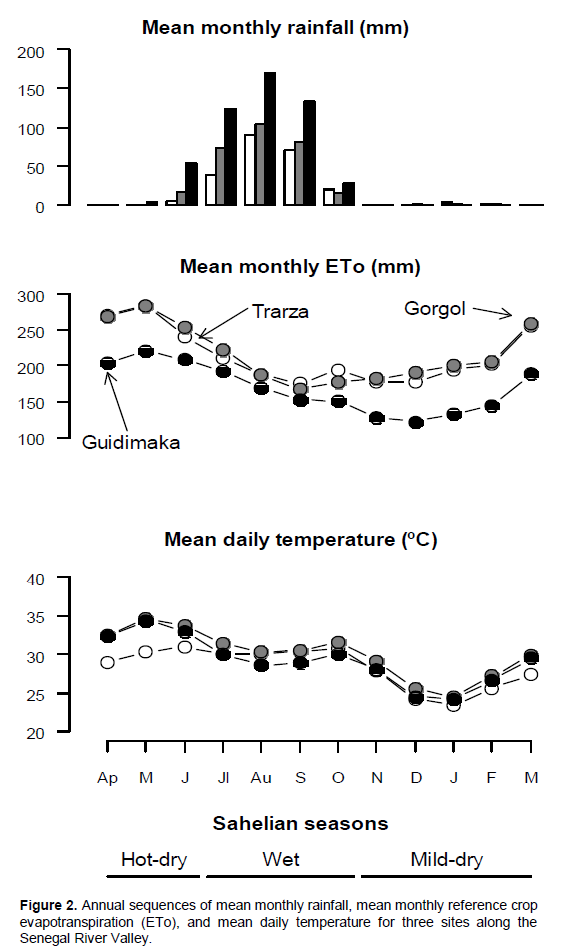
On average almost a quarter (22%) of surveyed households have no livestock, nearly half (45%) have only small ruminants, very few have only cattle (4%), but nearly a third (29%) have both small ruminants and cattle. The analysis reveals that there is no clear trend in household type with increasing rainfall from West to South-East (Figure 3). However, it reveals that there are significant differences in the distribution of TLU per resident between households that only have small ruminants and those having both small ruminants and cattle, with median values of 0.09 and 0.37, respectively. While there are no significant differences along the gradient of rainfall for those having only small ruminants, there are for those having both small ruminants and cattle.

The analyses presented in this study to evaluate the impact of livestock on household economy and capacity to meet food requirements, focus on households having small ruminants and both small ruminants and cattle with current access to irrigation. These have the capacity to add a second crop after wet-season rice; they comprise 50 and 63% of households having only small ruminants and small ruminants and cattle, respectively. For these households, labor is readily available (median number of adults active in agriculture is 5).
Survey data (Table 1) show that average productivity of animals varies markedly between regions, showing a strong West to South-East increase, positively correlated with rainfall. The difference is seen especially in milk production (270 to 480 kg per cow and 45 to 120 kg per sheep or goat) in response to the availability of green fodder. This distinction is not significant in meat production, indicating than meat production is less affected by the lack, or quality, of fodder than milk production. Human consumption of fresh milk and meat are essentially similar in all villages. Average annual consumption is 144 and 30 kg per person of fresh milk and meat, respectively, consistent with FAO data on consumption of these foods in Mauritania. Survey data reveal that fodder concentrate is required annually from 120 to 60 days from West to South-East. The survey established a clear trend in the average supply of fodder concentrates, amounting to 430 to 130 kg TLU-1 year-1 from West to South-East. Average daily quantities supplied to livestock are 2.9 kg DM TLU-1 day-1, well below the recommended intake (6.8 kg DM TLU-1 day-1). Average fodder concentrate supplied to livestock is 60% groundnut meal and 40% paddy bran.
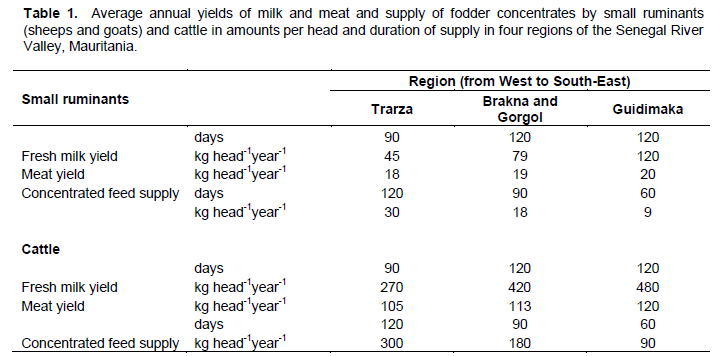
In households that have only small ruminants, the median value of the ratio of household milk and meat production to consumption is 0.15 and only 1% of these households produce more milk and meat than they consume. In households having both small ruminants and cattle, by contrast, the median value is 0.51 with 25% of households producing more than they consume. Along the valley this ratio is fairly stable for both types of households. However, especially in the South-East, there are some households with livestock production well in excess of consumption. This pattern is similar to the distribution of TLU per resident, that is, households that produce least are in the center of the valley.
Market prices
Market prices of both sorghum and cowpea remain fairly high and stable because households consume most of their production. Survey data show annual market prices for grain in Trarza, Brakna and Gorgol in the ranges 148 to 165 MRO kg-1 for sorghum and 160 to 180 MRO kg-1 for cowpea and somewhat lower in Guidimaka (MRO: Ouguiya, the Mauritanian local currency, 1 € = 385 MRO) (Table 2). Market price of sorghum stover ranges from 32 to 12 MRO kg-1, from West to South-East, and that of cowpea haulms from 60 to 20 MRO kg-1. Average milk market price increases from Trarza to Gorgol for both small ruminants (200 to 350 MRO kg-1) or cow (227 to 349 MRO kg-1), but it is much lower in Guidimaka (200 and 120 MRO kg-1, respectively). Average market prices of meat follow a decreasing trend of 1,160 to 900 MRO kg-1 for small ruminants and 950 to 700 MRO kg-1 for calf meat from West to South-East. During the hot-dry season, average market price of paddy bran averages 18 MRO kg-1. Market price of groundnut meal increases slightly from West to South-East, from 120 to 130 MRO kg-1 (Table 2).
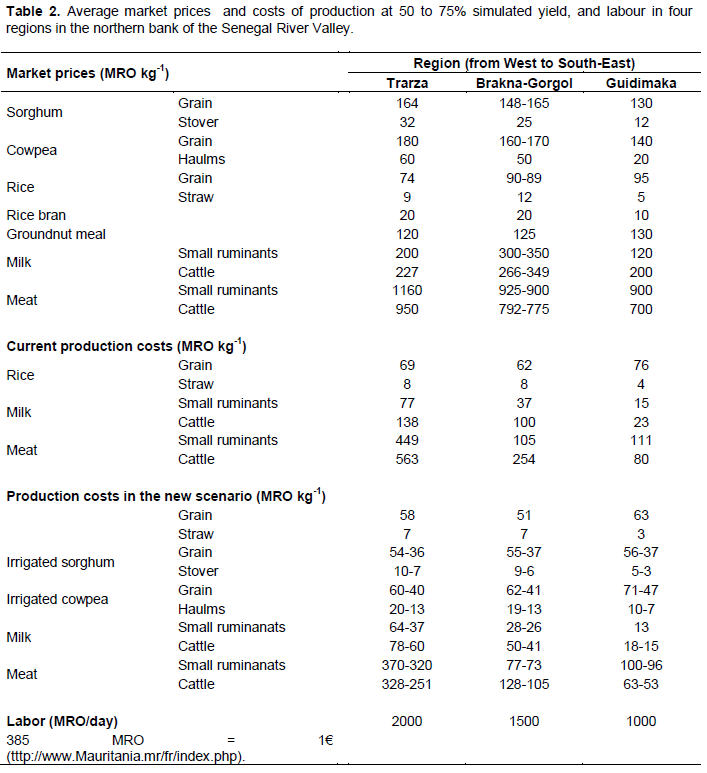
Current household net agricultural production
Differences in current production costs of milk and meat between regions are much greater than those in market prices mainly due to differences in availability of pasture and crop residues, the latter mostly from the larger areas of traditional crops rather than from rice. Higher rainfall in the South-East (Guidimaka) makes pasture and crop residues from traditional crops more available than in the West (Trarza) making costs of production of livestock in the South-East lower in the West where more feed concentrate is used. From West to South-East, average cost of milk production ranges from 138 to 15 MRO kg-1 and of meat, from 563 to 80 MRO kg-1. In Guidimaka, the region of highest rainfall, production costs are well below of those of other regions (Table 2).
For households having only small ruminants, median current household net agricultural production is 370,000 MRO per household, equivalent in value to about 230 working days (average daily cost is 1,500 MRO (Figure 4). The contributions of the various products are: livestock 51% (57% milk and 43% meat), traditional crops 42% (100% grain), and rice 7% (86% grain and 14% straw). By contrast, median current net agricultural production of households having both small ruminants and cattle it is 996,000 MRO per household, equivalent to 665 working days. Livestock contribute most, 78% (79% milk, 21% meat), followed by traditional crops 19% (grain) and rice 3% (87% grain, 13% straw). These data reveal the difference of the economies of these two types households in livestock production, particularly for milk. In the most arid region, Trarza, these differences are much smaller. These data also show that rice production returns much less than traditional crops and livestock.
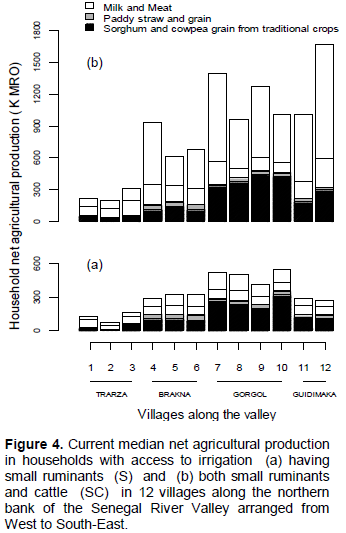
Inclusion of irrigated late mild-dry season crops in the current scenario
At current average grain yields (3.5 t ha-1), production of one rice crop per year in small and medium-sized collective perimeters (< 100 ha) can barely cover the cost of production and cannot repay loans or maintain pumping equipment and the irrigation schemes themselves (Comas et al., 2012). Analyses by Borgia et al. (2013) reveal how conditions of irrigation schemes fall easily into a spiral of degradation unless external financial support is provided. The record of abandonment of these irrigation schemes demonstrates that such funds are not commonly available (Mateos et al., 2010; García-Bolaños et al., 2011; Borgia et al., 2012). However, experimental data show that rice yields can be significantly increased with a good management of nutrients and weeds (van Asten et al., 2003; Haefele et al., 2001, 2004; Poussin et al., 2003, 2006) and by transplanting proper seedlings (García-Ponce et al., 2013). The proposal presented here to counter this spiral of degradation is the inclusion of irrigated sorghum and cowpea crops grown late in the mild-dry season (from December to March). The objective is to replace fodder concentrates, currently purchased mostly abroad to sustain livestock during the ensuing hot-dry season, with fodder grown in the irrigation schemes. The idea of cultivating irrigated sorghum and cowpea in the mild-dry season is not new. In fact, field trials were conducted by IRAT (Institut de Recherches Agronomiques Tropicales et des Cultures Vivrières) and ISRA (Institut Sénegalais de Recherches Agricoles) in the late 1960s (Chantereau, 1983), and subsequently by CNRADA (Centre National de Recherche Agronomique et de Développement Agricole) (Sy Aly, personal communication). What is new, is growing irrigated sorghum and cowpea planted late in the mild-dry season (December or January), after rice harvest in November-December. The impact of this delay of planting on productivity was unknown because, apart from some recent attempts to promote forage crop production for peri-urban milk producers (Toutain et al., 2009), there has been no experimental work during this season in Mauritania. For this option to be feasible, it must be demonstrated that the required investment is affordable and the production costs of grain and fodder are below market price. The decision to develop a second irrigated crop to replace fodder concentrate should be a collective decision taken by the cooperative as a whole.
Since flood recession cropping on Walo remains an option during the mild-dry season there exists potential for clashes for workload with irrigated crops sown late in the mild-dry season. In practice, however, there are opportunities to attend to both activities because of differences in timing of cropping operations and the small areas involved. In traditional Walo land, cropping starts in October-November and harvest is well underway or completed in February. By contrast, irrigated mild-dry season crops are sown after rice harvest at the end of December and harvested in March. In addition, given the small areas involved (median of 1.3 ha per household) this operations can be performed by one active person (Comas et al., 2012) while survey data indicate availability of 5 adults per household. Furthermore, unlike the traditional lands that are often located at 2 to 5 km from villages, irrigated plots are close by, facilitating the most time-consuming operations like bird control and harvesting.
Simulation of yield and development of irrigated late mild-season crops
Crop simulation results show that as planting is delayed (from late December to late January) sorghum yield increases more in Trarza (5.2 to 5.9 t ha-1), which is cooler than Gorgol and Guidimaka (5.2 to 5.5 t ha-1). In contrast, the productivity of cowpea, that is less adapted to high temperatures, increases in Trarza (2.6 to 3.0 t ha-1), but decreases in Gorgol (2.5 to 2.2 t ha-1) and Guidimaka (2.7 to 2.5 t ha-1). On the other hand, simulated irrigation water requirement of sorghum and cowpea sown late in the mild-dry season (day 360) are 85 and 39%, respectively, of rice in the wet season, ranging from 960 to 700 mm (day 200) from West to South-East (Figure 5). Since rainfall during this period is negligible, the pattern of irrigation water requirement reflects increasing ETo associated with increasing radiation, wind speed and temperature (Figure 2). In all regions irrigation requirement increases as sowing date is delayed. The smaller irrigation water requirement at Guidimaka compared with the other two regions derives from lower ETo (Figure 4). Sorghum requires more water than shorter-season cowpea and produces more biomass. For the first planting date (day 360), average irrigation requirements are 800, 760 and 490 mm in Trarza, Gorgol and Guidimaka, respectively. Both water requirements and simulated yield of cowpea are about half those of sorghum. This is relevant because irrigation water is about 22% of the total costs of irrigated crop production. These results also show that yields in the mild-dry season were higher than in the wet season, arguably a result of greater solar irradiance under cloudless skies (Connor et al., 2008).
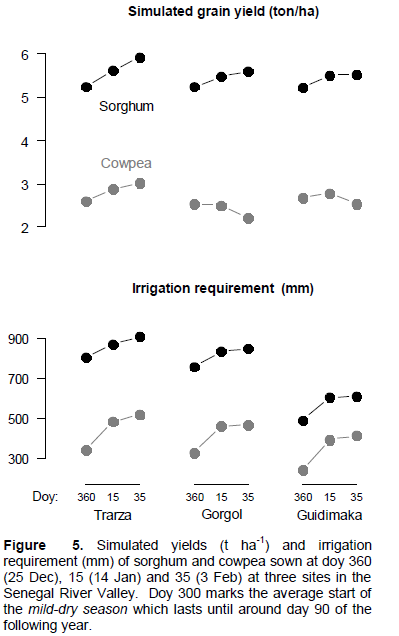
Simulation analysis shows that the introduction of irrigated crops sown late in the mild-dry season (equal areas of sorghum and cowpea) increases annual mean grain production by 62 kg per resident at 50% of yield obtained by simulation, and to 92 kg per resident at 75%. These are relatively high values with respect to current average annual production of these grains from traditional crops (104 kg per resident) and the annual consumption of sorghum and cowpea, which together with wheat and maize amount to around 120 kg per resident (Comas et al., 2012). On the other hand, simulation results show that annual fodder supplied by irrigated crops planted late in the mild-dry season (2/3 sorghum stover and 1/3 cowpea haulms) is 408 kg DM per TLU at 50% of simulated yield and 612 kg DM per TLU at 75% which represents 64% and almost 100% of fodder requirement during the subsequent hot-dry season at 50 and 75% yield obtained by simulation, respectively.
Household net agricultural production in the new scenario
Using conservative grain yields, ranging between 2.8 to 4.1 and 1.4 to 2.1 t ha-1, for sorghum and cowpea, respectively, the analysis of production costs of irrigated sorghum and cowpea establishes a positive margin, relative to annual average market price, for both grain and fodder of 40 to 24%. In addition, replacing fodder concentrates by fodder from irrigated mild-dry season crops reduces costs of livestock fodder during the hot-dry season, with an average saving relative to fodder concentrate of 20 to 30% for small ruminants and of 40 to 50% for cattle. Furthermore for the same expenditure these irrigated mild-dry season crops also produce highly valued grain for human consumption at a cost competitive with the market price. Finally, irrigated mild-dry season crops contribute to the amortization charges of the irrigation scheme, currently borne entirely by wet season rice production. On average this offers an average cost saving of milk and meat production from small ruminants of 20% relative to fodder concentrates.
The biggest savings occur with cattle with mean cost reduction of 40% in Trarza, Brakna and Gorgol, although less in Guidimaka (20%) where less concentrate is required (Table 1). Inclusion of irrigated mild-dry season crops also provides opportunity for families with few livestock to earn cash. This applies especially to households having only small ruminants because they have fewer livestock (median 0.08 TLU per resident) compared those with both small ruminants and cattle (median 0.45 TLU per resident).
Estimated median household net production of sorghum and cowpea grain in the new scenario range from 77,000 to 135,000 MRO per household at yields ranging between 2.8 to 4.1 and 1.4 to 2.1 t grain ha-1, for sorghum and cowpea, respectively. The households that would most benefit from irrigated second crops are those of Trarza and Gorgol (Table 2) where the prices of sorghum and cowpea grain are higher than in the other regions (Table 1). On the other hand, estimates of median annual household saving in production of livestock with fodder from irrigated mild-dry season crops range from 4,000 MRO per household with only small ruminants to 37,000 to 52,000 MRO for those with both small ruminants and cattle. The biggest savings are obtained in Trarza, where median annual savings are 7,000 to 9,000 and 44,000 to 74,000 MRO per household having only small ruminants and those having both small ruminants and cattle, respectively (Table 3). These greater savings can be explained by the small areas of traditional crops and pastures there relative to other regions. In addition, households that do not consume all the fodder produced by the second irrigated crop have surplus for sale. This possibility is especially open to households having only small ruminants, for which median annual net production obtained from the sale of surplus fodder range from 24,000 to 52,000 MRO. The median value for households having both small ruminants and cattle is zero. Households in Trarza and Guidimaka benefit most because stocking rate and fodder demand are greater than in other regions.
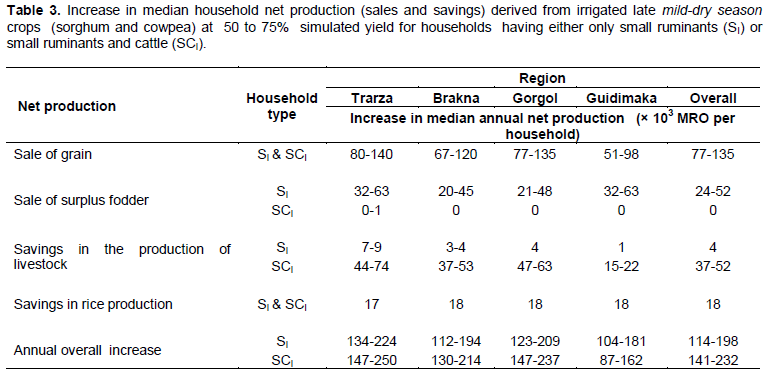
In summary, the introduction of irrigated sorghum and cowpea sown late in the mild-dry season increases household median annual net agricultural production of households having only small ruminants by 114,000 to 198,000 MRO, while for households having both small ruminants and cattle these corresponding values are 141,000 to 232,000 MRO. The largest contribution to that increase is in the production of grain sorghum and cowpea (54 to 63%) and in the production of fodder specially for to households having only small ruminants (3 to 27%), followed by reduced costs of rice production because of sharing scheme costs (9 to 16%) and by smaller cost of feeding the animals during the ensuing hot-dry season (3 to 27%). The result of differences in cropping patterns, stocking rates and population between regions confers most benefit from irrigated late mild-dry season crops in Trarza and Gorgol where the prices of sorghum and cowpea grain and fodder are higher than in the other regions.